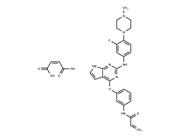| Name | Asenapine Maleate |
| Description | Asenapine Maleate (Org 5222 maleate) is a second generation (atypical) antipsychotic agent that is taken sublingually and used in the treatment of schizophrenia and manic or mixed episodes associated with bipolar 1 disorder. Asenapine is associated with a low rate of transient and mild serum aminotransferase elevations during therapy but has not been linked to instances of clinically apparent acute liver injury. |
| Kinase Assay | In vitro kinase activity: GST-FAK in vitro kinase activity is measured and compared to His-tagged FAK 411–686 using the K-LISA screening kit and poly(Glu:Tyr) (4:1) copolymer as a substrate immobilized on microtiter plates. IC50 values are determined with various concentrations of test compounds in a buffer containing 50 μM ATP and 10 mM MnCl2, 50 mM HEPES (pH 7.5), 25 mM NaCl, 0.01% BSA, and 0.1 mM Na orthovanadate for 5 min at room temperature. Serial diluted compounds are tested in triplicate. Substrate phosphorylation is measured using horseradish peroxidase-conjugated anti-pTyr antibodies with spetrophotometric color quantitation. IC50 values are determined using the Hill-Slope Model. Kinase selectivity profiling is performed by using the KinaseProfiler service. |
| In vitro | Asenapine (0.01 mg/kg, i.v.) preferentially increased dopamine outflow in the shell compared to the nucleus accumbens (NAc) core, with no difference observed at a higher dosage (0.05 mg/kg, i.v.). Asenapine significantly enhanced the response to NMDA in pyramidal cells within the medial prefrontal cortex. In freely moving rats, Asenapine (0.05-0.2 mg/kg, subcutaneous injection) induced dose-dependent conditioned avoidance response (CAR) inhibition (without recording escape failures) and did not induce cataleptic fainting. Moreover, Asenapine (0.05-0.2 mg/kg, subcutaneous injection) increased dopamine outflow in both the medial prefrontal cortex and the nucleus accumbens in rats. |
| In vivo | Asenapine demonstrates a higher affinity for 5-HT 2C, 5-HT 2A, 5-HT 2B, 5-HT 7, 5-HT 6, alpha2B, and D3 receptors compared to its affinity for D2 receptors, indicating a closer interaction with these targets at therapeutic doses. Asenapine is an effective antagonist for a range of receptors, including 5-HT 1A (7.4), 5-HT 1B (8.1), 5-HT 2A (9.0), 5-HT 2B (9.3), 5-HT 2C (9.0), 5-HT 6 (8.0), 5-HT 7 (8.5), D2 (9.1), D3 (9.1), alpha2A (7.3), alpha2B (8.3), alpha2C (6.8), and H 1 receptors (8.4), as indicated by their respective pKB values. |
| Storage | Powder: -20°C for 3 years | In solvent: -80°C for 1 year | Shipping with blue ice. |
| Solubility Information | H2O : < 1 mg/mL (insoluble or slightly soluble)
DMSO : 60 mg/mL (149.31 mM), Sonication is recommended.
Ethanol : < 1 mg/mL (insoluble or slightly soluble)
|
| Keywords | inhibit | Asenapine Maleate | Org5222 | Inhibitor | Org-5222 | Org 5222 Maleate | 5-HT Receptor | 5-hydroxytryptamine Receptor | Serotonin Receptor | Asenapine |
| Inhibitors Related | Alverine citrate | Olanzapine | Dapoxetine hydrochloride | CLOZAPINE N-OXIDE | Amitriptyline hydrochloride | Cloperastine hydrochloride | Trazodone hydrochloride | Mianserin hydrochloride | Fluoxetine hydrochloride | Cinchonidine |
| Related Compound Libraries | Bioactive Compound Library | Anti-Neurodegenerative Disease Compound Library | Pain-Related Compound Library | Membrane Protein-targeted Compound Library | EMA Approved Drug Library | Drug Repurposing Compound Library | Inhibitor Library | FDA-Approved Drug Library | Bioactive Compounds Library Max | Anti-Cancer Drug Library |

 United States
United States



